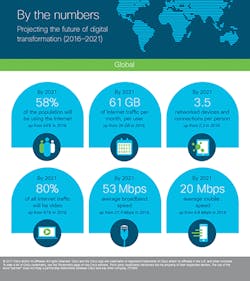Latest from 5G/6G & Fixed Wireless Access/Mobile Evolution
8 Key Predictions That Impact YOUR Network Strategy:
Over the next 5 years, 2016-2021, global digital transformation will continue to have a significant impact on the demands and requirements of IP networks according to the Cisco Visual Networking Index™ (VNI) Complete Forecast.
Top-level indicators include the projected increase in Internet users — from 3.3 to 4.6 billion or 58% of the global population, greater adoption of personal devices and machine-to-machine (M2M) connections — from 17.1 billion to 27.1 billion from 2016-2021, average broadband speed advances — from 27.5 Mbps to 53.0 Mbps, and more video viewing — from 73% to 82% of total IP traffic. Over the forecast period, global IP traffic is expected to increase threefold reaching an annual run rate of 3.3 zettabytes by 2021, up from an annual run rate of 1.2 zettabytes in 2016.
For the first time in the 12 years of the forecast, M2M connections that support Internet of Things (IoT) applications are calculated to be more than half of the total 27.1 billion devices and connections, and will account for 5% of global IP traffic by 2021. IoT innovations in connected home, connected healthcare, smart cars/transportation and a host of other next-generation M2M services are driving this incremental growth — a 2.4-fold increase from 5.8 billion in 2016 to 13.7 billion by 2021.
Video will continue to dominate IP traffic and overall Internet traffic growth — representing 80% of all Internet traffic by 2021, up from 67% in 2016. Globally, there will be nearly 1.9 billion Internet video users (excluding mobile-only) by 2021, up from 1.4 billion in 2016. The world will reach 3 trillion Internet video minutes per month by 2021, which is 5 million years of video per month, or about 1 million video minutes every second.
Emerging mediums such as live Internet video will increase fifteenfold and reach 13% of Internet video traffic by 2021 — meaning more streaming of TV apps and personal live streaming on social networks. While live streaming video is reshaping today’s online entertainment patterns, virtual reality (VR) and augmented reality (AR) are also gaining traction. By 2021, VR/AR traffic will increase twentyfold and represent 1% of global entertainment traffic.
"As global digital transformation continues to impact billions of consumers and businesses, the network and security will be essential to support the future of the Internet," said Yvette Kanouff, SVP and GM of Service Provider Business, Cisco. "Driving network innovation with service providers will be key for Cisco to support the needs of their customers who want reliable, secure, and high-quality connected experiences."
8 Key Predictions
Prediction #1
Global IP will grow threefold from 2016-2021.
• Global IP traffic is expected to reach 278 exabytes per month by 2021, up from 96 exabytes per month in 2016.
• Global IP traffic is expected to reach an annual run rate of 3.3 zettabytes by 2021.
• Busy hour Internet traffic is increasing faster than average Internet traffic. Busy hour Internet traffic will grow 4.6-fold (35% CAGR) from 2016 to 2021, reaching 4.3 Pbps by 2021, compared to average Internet traffic that will grow 3.2-fold (26% CAGR) over the same period reaching 717 Tbps by 2021.
Prediction #3
Globally, total public Wi-Fi hotspots (including homespots) will grow sixfold from 2016 to 2021 from 94 million in 2016 to 541.6 million by 2021.
• Globally, total Wi-Fi homespots will grow from 85 million in 2016 to 526.2 million by 2021.
• Leading hotspot countries: China (170 million by 2021), US (86 million by 2021), Japan (33 million by 2021), and France (30 million by 2021).
Prediction #4
By 2021, more than half (56%) of connected flat panel TV sets will be 4K up from 15% in 2016.
• Installed/In-service 4K TV sets will increase from 85M in 2016 to 663M by 2021.
Prediction #6
End-user Internet traffic is moving closer to the edge — over one-third of traffic will bypass core by 2021
• Globally, 35% of Internet traffic will be carried metro-to-metro by 2021, up from 22% in 2016.
• Globally, 23% of Internet traffic will be carried on regional backbones (without touching cross-country backbones) by 2021, compared to 20% in 2016.
• Globally, 41% of Internet traffic will traverse cross-country backbones by 2021, compared to 58% in 2016.
Prediction #7Global enterprise SD-WAN traffic. • SD-WAN traffic will grow at a CAGR of 44% compared to 5% for traditional WAN. • SD-WAN will increase sixfold over the forecast period and represent 25% of WAN traffic by 2021.
Prediction #8
Average Distributed Denial of Service (DDoS) attacks size increasing steadily and approaching 1.2 Gbps — enough to take most organizations completely offline.
• DDoS incidents can paralyze networks by flooding servers and network devices with traffic from multiple IP sources.
• The peak attack size increased 60% year over year and represents up to 18% of a country’s total Internet traffic while they are occurring.
• Average DDoS attack size increased to 22%, which is relatively the same rate as Internet traffic at 29% year over year.
• The number of DDoS attacks grew 172% in 2016 and will increase 2.5-fold to 3.1 million by 2021 globally.
For more information about Cisco Visual Networking Index Predicts Global Annual IP Traffic to Exceed Three Zettabytes by 2021, please visit https://newsroom.cisco.com/press-release-content?type=webcontent&articleId=1853168. To view the infographic in total and to download the full report Cisco Visual Networking Index, Forecast and Methodology, 2016-2021, please visit VNI Complete Forecast Update, 2016-2021 at http://www.cisco.com/c/en/us/solutions/service-provider/vni-network-traffic-forecast/infographic.html?CAMPAIGN=VNI+2017&COUNTRY_SITE=us&POSITION=Press+Release&REFERRING_SITE=Cisco+page&CREATIVE=PR+to+VNIMRM+Infographic.
Save
Save
Save
Save











